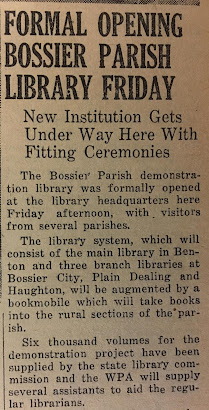 |
| Color drawing of Bossier High School by Louisiana artist Stan Routh |
Since the high school began during the first world war, there were only female graduates for the first three years. By 1920 the number of graduates began to increase along with the number of students attending the school. The school continued to grow, and by 1926 it fielded its first football team.
With the school colors, kelly green, and white, already having been selected in 1925, all the team needed was a mascot. Arthur Ray Teague was the team’s first fullback, and he is credited with choosing the bearcat as the mascot. Buzz Wojecki explains in an article published in the Bossier Press-Tribune in 2006, “The spelling changed from ‘Bearcats’ to ‘Bearkats’ about 1938. There is good reason to believe it was to differentiate Bossier High from the Ruston High Bearcats on the sports page.”
 |
| In 2006 Bossier High School alumni, school officials, and Bossier City Mayor Lo Walker unveiled a sign at Bossier Elementary School commemorating 80 years of Bearkat football. |
The first Bearkat football players were: Pue L. Wilson, Pat Stevens, Willie Chambers, James Nelson, Charles Hoyer, Harry Bumgardner, Briscoe Marlar, Tap Waller, David Wallace, Arthur Ray Teague, Maurice Birdwell, Pete McCall, Virgil Gleason, Julius Whisenhunt, and Mack O’Quinn. Stuart Storey, a former freshman coach at Louisiana College, was the first coach for the Bearkats, leading them to victory in their first game on the gridiron, defeating Doyline High School by four points; final score 18 to 14.
That first year the team played seven games and tied three, lost three, and won two making a total of seven touchdowns. The first three touchdowns were made by Harry Baumgardner, who also made one more during that season. Arthur Ray Teague made two, and Maurice Birdwell made one. Not bad, considering they were a first-year team.
The Bearkat football team had a perfect season in 1933; they were undefeated and unscored on that year. They won the Louisiana State Class "A" Championship in 1942 and again in 1948.
 |
| The Shreveport Times Aug. 4, 1995 |
Some star players went on to college and then to the pros, such as Eugene “Red” Knight, a fullback who graduated in 1943. He went on to Louisiana State University, and then he played for the Washington Red Skins, the Chicago Cardinals, and the San Francisco 49ers during his professional career.
Then there were the Walker brothers, Wayne, a 1962 graduate, and Randy, a 1969 graduate. Both were kicking stars that went on to Northwestern State University and then to the pros. Wayne played for the Kansas City Chiefs, the Houston Oilers, and the Texas Titans. Randy played for the Green Bay Packers and the Tampa Bay Buccaneers.
Learn more about the local high schools and football teams by visiting the Bossier Parish Libraries History Center, your leading source for local history. We are located adjacent to the Central Library branch at 2206 Beckett Street, Bossier City. Whether you want to learn about local history or research your family history, we are here to help.
By: Amy Robertson

















